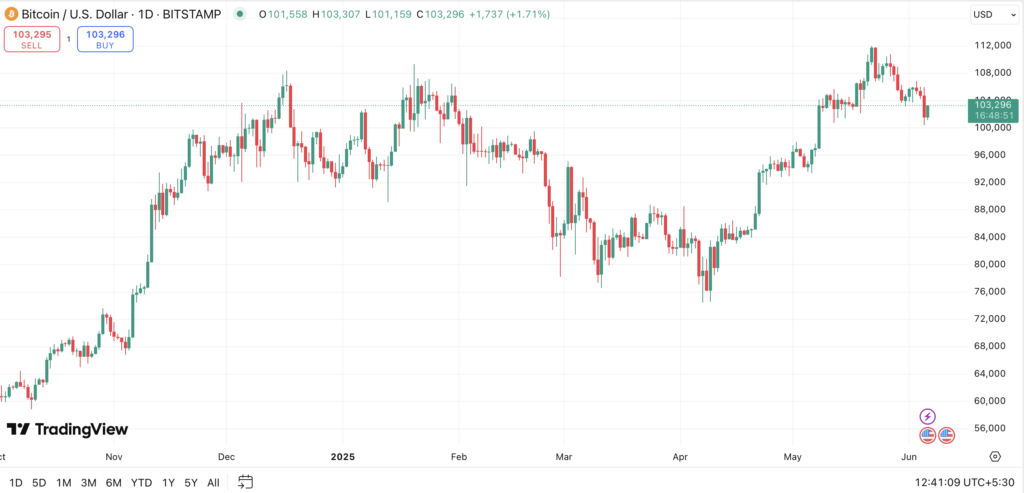Every time the Bitcoin Super Signal flashed before, markets surged. Now that it’s back, is it signaling latent momentum.
Bitcoin’s quiet volume may be its loudest signal yet
Bitcoin’s (BTC) price has eased slightly since reaching a peak of $111,970 on May 22, pulling back to around $103,300 as of June 6, a decline of approx 8%.

Despite the drop, institutional appetite appears to remain intact. U.S. spot Bitcoin ETFs recorded around $5.24 billion in net inflows during May, suggesting that investor interest has not diminished with the slowdown in price momentum.
Meanwhile, sentiment indicators are showing a neutral picture. The Crypto Fear and Greed Index stands at 46, placing the market in the “Neutral” zone and waiting for further triggers.
Amid this, on-chain analyst CryptoCon has highlighted a rare but historically consistent pattern known as the “Bitcoin Super Signal.” The signal is triggered when trading volumes fall to extremely low levels while prices remain in a broader uptrend.
Based on CryptoCon’s data, current trading volume is at its lowest level since 2014. Only three previous instances have met the same criteria. Each one was followed by a significant bull run.
So far, there is no clear evidence that the current cycle has reached a peak. Bitcoin continues to trade within bullish territory, while volume continues to decline. Historically, this combination has preceded sharp upward moves, even if the market appears quiet on the surface.
To make sense of what this signal could mean now, we need to look at its previous appearances, how each one played out, and why it tends to emerge when market conditions appear deceptively calm.
Decoding Bitcoin’s Super Signal
In Bitcoin’s chart history, sharp rallies often emerge after extended periods of low activity. The Volume Oscillator Super Signal is one of the few indicators that captures this pattern by using volume, rather than price, as the leading input.
It highlights moments when trading activity drops to historically low levels while the broader trend remains upward. Only four such signals have appeared: December 2012, October 2016, September 2023, and most recently, June 2025.
The indicator works by applying a volume oscillator to Bitcoin’s monthly chart. When volume dips below a defined threshold during a bull trend, it signals a shift in market structure. Most sellers have likely exited, and buyers may be accumulating with minimal resistance.
From a liquidity perspective, this implies reduced supply pressure. As a result, even moderate demand can push prices higher once market momentum returns.
In 2012, the signal appeared when Bitcoin was trading below $15. Over the following year, the price surged more than 10,600%, forming the 2013 bull cycle that brought Bitcoin into mainstream attention.
The next instance came in October 2016, when Bitcoin stood near $700. The cycle that followed peaked around $20,000 in late 2017, marking a 3,461% increase from the signal to the cycle top.
In both cases, the signal emerged during low-volume periods, not at moments of retail frenzy. Price was climbing steadily, but broader interest had not yet returned.
The same pattern repeated in September 2023. Bitcoin was trading around $25,000, volume dropped into the “extreme low” zone, and the market remained cautious due to macro uncertainty. Within six months, Bitcoin reached $75,000, posting a 200% gain.
Institutional investors are still buying the dip
The latest Super Signal appeared in June 2025, as the Volume Oscillator dropped into its extreme low zone.
Current readings show the lowest volume level since 2014, despite Bitcoin still trading above $100,000 and U.S. spot ETFs continuing to record multi-billion dollar inflows.
The contrast may seem counterintuitive, but historically, low volume in a bullish setup often signals that sellers have exited and buyers are accumulating quietly.
In such conditions, market depth shrinks. Even moderate inflows of capital can move prices significantly due to a lack of sell-side resistance.
Chart data supports this pattern through color-coded volume zones. Red boxes, which mark volume blow-offs and often indicate market tops, have consistently appeared at the end of previous bull cycles, including in 2014, 2018, and 2021. None has appeared so far in this cycle.
In contrast, blue-circled areas highlight the Super Signals — moments when volume reaches deeply suppressed levels while the trend remains upward. These signals have historically emerged at early or mid-stages of a rally, not at its end.
The current chart closes with a question mark near today’s price, suggesting the current move may still be unfolding.
It is important to distinguish between Super Signals and standard volume pivots.
Not all volume dips lead to strong rallies. Green-circled pivots on the oscillator identify periods of moderately low volume followed by smaller upward moves. Super Signals occur only when volume is at unusually low levels and the broader price structure remains intact.
Macroeconomic conditions add further context. The fiscal environment has shifted once again following the passage of the “One Big Beautiful Bill,” which brought renewed government spending and added concerns about long-term liquidity.
Meanwhile, inflation expectations remain elevated, and risk assets are increasingly pricing in the possibility of a softer global monetary stance.
In that backdrop, Bitcoin holds a structurally favorable position. ETF flows continue to provide consistent demand. Sell-side pressure remains limited, and trading volumes are compressed, creating a setup where price can move quickly if fresh capital enters.
On-chain behavior reflects a shift back toward accumulation. According to Glassnode, wallets holding between 10 and 100 BTC now show a perfect accumulation score of 1.0, indicating strong, sustained buying activity.
The same score has been recorded in wallets holding less than 1 BTC, suggesting retail interest is also building.
Accumulation during low-volume phases typically reflects optimism. Participants are not rushing in, but they are positioning quietly, waiting for confirmation before larger moves unfold.
As always, crypto markets are highly volatile and nothing is ever guaranteed. Do your own research and never invest more than you can afford to lose.
